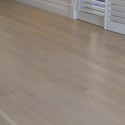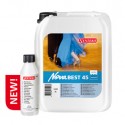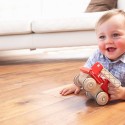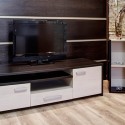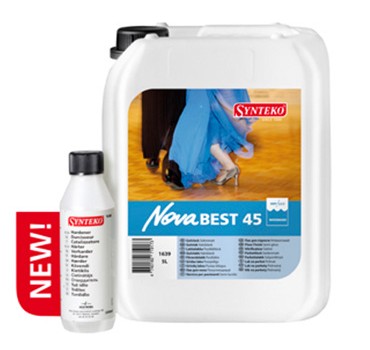
When using water-based finishes, the thing to keep in mind is that you are working with water. Equipment and techniques of application are different from solvent based polyurethane and oil finishes.
Below is a list characteristic that are unique to water based finishes.
- Grain raise; this is unavoidable with water-based coating. Do not become anxious about it, just anticipate it and prepare for it. One must sand the floor to a finer grit than say polyurethane. Do not be worried about over buffing the wood. Screening to 120/150-grit is not good enough. Finishing with a 180-220 grit or finer will give a better result (buff with a blue magic pad or maroon pad as well) before applying water-based coating. Water popping the grain before the final screening is also helpful in finishing up with smooth water-based floors and helps charge the timber pores with water prior to application.
- Do not go over already applied water-based coating. They set up much faster than polyurethane or oil. Water-base finishes usually flows out well on its own. Brushing after the finish starts to set will cause it to ball up and remain that way. Resist the temptation to keep brushing and re-brushing. Over rolling and rolling too fast will result in bubbles. Fix any flaws after the coat has fully dried. (Just try not to leave any flaws on the last coat). Always brush/coat with the grain.
- Thoroughly mix the finish before coating especially if it is a 2 pack water base. Not mixing the finish correctly can cause streaking in the final appearance and /or coagulation of the product in the bottle. This latter problem will result in gel particles appearing in the final coat.
- Clean and Tack mop the floor before each coat. It is even a good idea to clean the window sills and counter tops. A clean home provides for a perfect finish.
- Apply an even pressure or no pressure to the applicator. Different pressures can lead to varying film thicknesses, which could lead to varying sheens and will leave lines in the coat. Be consistent with your application across the floor.
- Try to achieve the recommended coverage rates. Finishes are designed to be applied at a specific film thickness. If you apply the finish at the recommended rate it will have a better chance to flow and level. Avoid over coating an already “wetted” floor area as there will be a colour difference such as picture framing.
- Make sure to turn off the A/C system and close all windows and doors while coating to stop air flow over the coating while it is being applied. This will keep the finish from drying too quickly. After 30 minutes of no airflow the finish will tack over, at this point open up all doors and windows in order to allow airflow over the floor. Use fans to remove the solvent from the room. The off gassed solvent is denser than air and, if not removed, will fall back on the floor unless the room has been properly ventilated. A well ventilated floor insures that the coating will cure resulting in a strong and durable finish.
The following is six points are summary of principles that one should always keep in mind when working with water based finishes:
- MIXING – Read your labels. Some coatings are shaken whilst others need stirring. All have a rest period before use to remove bubbles. The label will tell you what application tools are recommended, proper spread rate and method of applying your next coat of finish.
- AIRFLOW – During application, allow little or no airflow. Once finish has set around 30 minutes, start air flowing away from the floor (first remove finish solvents from the room). A minimum of three hours of aggressive ventilation is a good rule of thumb before leaving the job site. Always insure that there is ongoing ventilation. Remember: never blow directly on the floor as it will cause skimming.
- SUNLIGHT – Do not coat in direct sunlight, when the floor or room is hot or during the hot portion of the day. Mask off the windows to eliminate direct sunlight on the floor before application to keep floor cool. Watch air vents and appliances that blow hot air across the floor. These situations can cause premature drying, skimming and streaking.
- TEMPERATURE – Acclimatise your finish to your job sites all year round. Do not leave the containers in the van or in the sun until you are ready to coat. Make sure the job site can maintain a proper temperature while the finish is drying and curing. Similarly, in winter do not leave the containers in the van overnight and acclimatise the coating. In the colder months coating the floor when it is too cold will not allow the coating settle properly.
- EXPECTATIONS – Keep your customer involved in all aspects of the job: kids, pets, dry times, curing, noise, odours, maintenance issues, cleaning kits, felt protectors on furniture where it will come in contact with floor surface, and – most importantly – how the floor is going to feel and look. It’s not furniture – it’s a wood floor. Answer their questions before they ask them.
- RECOATS – The life of the floor and the finish depend on maintenance and re-coats. It’s also a great way to keep your customer friend and add increase sales.
VENTILATION IN WATER BASE
Adequate ventilation is critical to ensure that the water base finish is:
- Sufficiently dry prior to re-coating
- To allow foot traffic across the floor finish
- To stimulate the curing process
VENTILATION DEFINED
Ventilation is the physical action of exchanging the ambient air in the house that contains solvents (from the floor coatings) with fresh air. Natural air flow is no substitute for good mechanical ventilation, which is the most effective means of ventilation. In addition do not solely rely on the air conditioning system as they will not necessarily remove all the solvents as they can become trapped in the filters and ducting.
